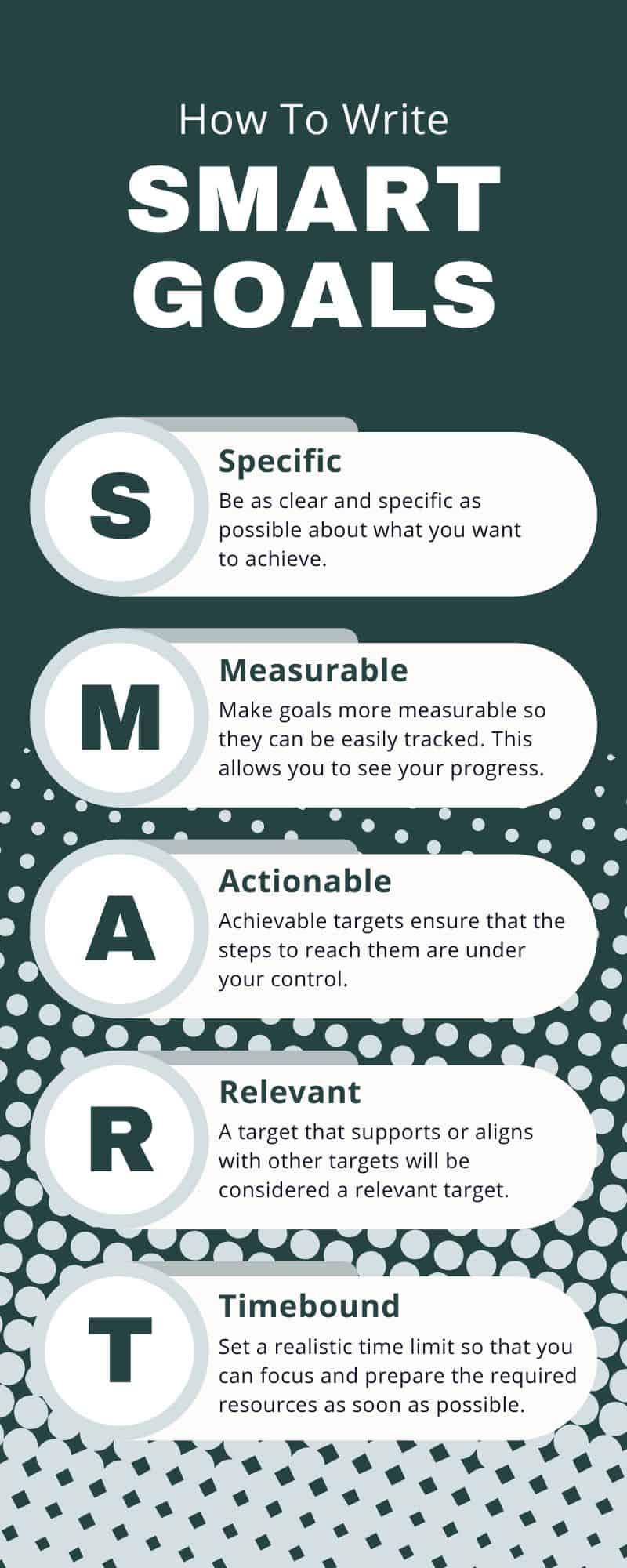When it comes to our overall health, wellness is extremely important. It’s not just about physical health but mental and emotional health as well. Wellness is about achieving balance in all areas of our lives. We'll show you how to set smart goals to achieve the healthy lifestyle of your dreams and give you 15 examples of wellness goals that will help you build a personal wellness plan.

Jump to:
The 4 types of wellness
1. Physical wellness
Physical wellness entails taking care of our bodies and making sure we are getting the exercise and nutrition we need. It also includes getting regular check-ups and screenings and being proactive about our health. Physical activity is also super important for our mental and emotional health as well as our immune system. Achieving optimal health begins with getting enough activity.
Here are some examples of physical wellness goals:
- Achieving a Healthy Weight: Develop a goal to reach and maintain a healthy weight through a combination of balanced nutrition and regular exercise.
- Improving Cardiovascular Fitness: Set a goal to engage in aerobic activities like brisk walking, jogging, or swimming to enhance your cardiovascular health.
- Enhancing Flexibility and Strength: Incorporate regular stretching and strength training into your routine to improve flexibility and build muscle.
Practical exercises
- Personalized Workout Routine: Design a workout plan that includes cardiovascular exercises, strength training, and flexibility-enhancing activities.
- Balanced Meal Plan: Create a meal plan that features whole foods, adequate hydration, and proper portion control.
- Activity Tracking: Monitor your daily steps or physical activity levels using a pedometer or fitness tracker.
2. Mental wellness
Mental wellness is about managing our stress levels, staying positive, and maintaining a healthy outlook on life. It’s about having a good support system and taking care of our mental health just as we would our physical health.
Here are examples of mental wellness goals:
- Continuous Learning: Set aside time for reading, taking online courses, or acquiring new skills to keep your mind sharp.
- Challenging Negative Thoughts: Learn cognitive behavioral techniques to identify and reframe negative thought patterns.
- Prioritizing Sleep: Establish a consistent sleep routine to ensure proper rest and cognitive functioning.
Practical exercises
- Learning Schedule: Allocate a specific time each day or week for learning new things or developing new skills.
- Positive Affirmations: Practice using positive affirmations to counteract negative self-talk and boost self-confidence.
- Sleep Hygiene Routine: Create a bedtime routine that promotes relaxation and optimal sleep quality.
3. Emotional wellness
Emotional wellness is about managing our emotions in healthy ways. It’s about being aware of our triggers and finding healthy coping mechanisms to deal with stress and difficult emotions. This can also include spiritual wellness that ties into your religious faith.
Consider these examples of emotional wellness goals:
- Practicing Self-Compassion: Develop a habit of speaking kindly to yourself and cultivating a positive self-image.
- Stress Management: Learn relaxation techniques, such as deep breathing and mindfulness, to effectively manage stress.
- Cultivating Gratitude: Make it a goal to focus on the present moment, count your blessings, and build emotional resilience.
Practical exercises
- Gratitude Journal: Maintain a journal where you jot down three things you're grateful for each day.
- Mindfulness Practice: Dedicate time daily to meditation or deep breathing exercises to calm your mind and reduce stress.
- Creative Expression: Engage in artistic or creative activities that help you express and process your emotions.
4. Social wellness
Social wellness is about having healthy relationships. It’s about having a strong support system and maintaining positive social interactions. It’s also about being active in your community.
There are many ways to achieve wellness in all areas of our lives, and wellness looks different for everyone. We would also argue that financial wellness should be a part of the main types of wellness but it always seems to be overlooked. An example of a financial wellness goal would be to pay off debt or open a savings account.
Consider these examples of social wellness goals:
- Nurturing Existing Relationships: Schedule regular interactions with friends and family to maintain strong connections.
- Expanding Your Social Circle: Step out of your comfort zone and make an effort to meet new people and form new friendships.
- Effective Communication: Practice active listening and improve your communication skills to enhance your relationships.
Practical exercises
- Social Calendar: Plan regular virtual or in-person meetups with friends and loved ones.
- Join Communities: Join clubs, classes, or online groups related to your interests to meet like-minded individuals.
- Empathetic Conversations: Engage in conversations where you focus on truly listening to the other person and understanding their perspective.

Why wellness is important?
Wellness is important because it helps us to be our best selves. When we are physically, mentally, and emotionally well, we are better able to handle the challenges life throws our way. We can also enjoy our lives more fully when we feel our best. Investing in our wellness is one of the best things we can do for ourselves.
Wellness is a state of being healthy in body, mind, and spirit. It is the result of making choices that lead to a more balanced and fulfilling life. When we are well, we have more energy, feel better emotionally, and are able to enjoy our lives more fully. By making small changes, we have a great opportunity to build lasting wellness through healthy habits and ultimately achieve our health goals.
More examples of wellness goals
There are many different types of wellness goals that you can set for yourself. It’s important to find what works best for you and your lifestyle. Some examples of wellness goals include:
- Eating a healthy diet
- Getting regular exercise (maybe you join a gym or hire a personal trainer to work on your personal wellness goals or exercise routine)
- Getting enough sleep
- Managing stress levels
- Staying positive
- Spending time with loved ones and friends
- Doing things that make you happy (maybe learning a new skill)
- Drinking enough water
- Eating a balanced breakfast every day
- Committing to a meditation practice
- Stretching daily
- Going to therapy
- Establishing a morning or evening routine
- Organizing your home and/or office
- Daily journaling
Whatever your goals may be, remember that wellness is a journey, not a destination. There is no “perfect” way to achieve wellness. Just focus on taking small steps each day to move closer to where you want to be. And don’t forget to enjoy the ride!
You may also have workplace wellness goals, such as joining or starting an employee or workplace wellness program. Employers often provide these programs as part of their work-life balance benefits and encourage healthy living to reduce healthcare costs, improve employee productivity and health, and promote overall wellness. Sometimes, workplaces even have support groups for a common goal like weight loss or smoking cessation.
What are the reasons to set wellness goals?
There are many benefits to setting goals for wellness. When we have specific goals in mind, we are more likely to take action and make positive changes. Goals can also help keep us motivated and on track. Additionally, accomplishing our wellness goals can give us a sense of pride and satisfaction.
Some other reasons why you may want to set goals for wellness include:
- Improving your overall health
- Reducing stress levels
- Increasing energy levels
- Improving sleep quality
- Boosting mood and outlook on life
Whatever your reasons may be, remember that it’s never too late to start working towards a healthier, happier life!
How to set wellness goals you'll actually stick to
There are a few things to keep in mind when you’re setting goals for wellness. First, be realistic about what you can realistically achieve. It’s important to set goals that challenge you but that are also achievable.
Secondly, make sure your goals are specific and measurable. This will help you to better track your progress and see how far you’ve come.
Finally, don’t forget to give yourself some grace along the way. There will be ups and downs, but as long as you keep moving forward, you'll eventually reach your goal!
You'll see that this is in line with setting a S.M.A.R.T. goal. The smart acronym is a mnemonic acronym that stands for Specific, Measurable, Achievable, Realistic, and Time-bound. This acronym is often used in goal setting to help ensure that goals are clear, attainable, and have a timeline.
Some examples of specific and measurable wellness goals include:
- I will eat at least 2 servings of fruits and vegetables each day.
- I will walk for 30 minutes 5 days per week.
- I will get 8 hours of sleep every night.
- I will stick to a morning routine 5 days per week.
- I will drink 8 glasses of water per day.
- I will meditate for 10 minutes each day.
These are just a few examples – there are endless possibilities when it comes to setting goals for wellness! Just remember to be creative, specific, and realistic, and you’ll be well on your way to achieving your goals.

Tips for achieving wellness goals
Once you’ve set your goals, it’s time to start working toward them! Here are a few wellness tips to help you along the way:
1. Make a plan
Write down your goals and make a plan for how you will achieve them. Setting clear and well-defined goals is the first step towards success. Take the time to articulate your goals and break them down into actionable steps. Create a roadmap that outlines how you'll progress from where you are now to where you want to be.
Example: If your physical wellness goal is to improve cardiovascular fitness, your plan could include setting a target number of minutes for daily aerobic exercises, gradually increasing intensity, and scheduling regular progress assessments.
2. Get support
Share your goals with a friend or family member and ask for their support. Having someone to share your progress with can provide encouragement, feedback, and a sense of camaraderie.
Example: If your mental wellness goal is to read more books, let a friend know about your goal and consider starting a book club together.
3. Stay positive
Believe in yourself and your ability to reach your goals. A positive mindset is crucial for staying motivated and resilient. Believe in your ability to achieve your wellness goals and practice positive self-talk. Instead of focusing on potential setbacks, visualize your success and the benefits that achieving your goals will bring.
Example: If your emotional wellness goal is to manage stress through mindfulness, remind yourself daily that you are capable of handling stress in a healthier way.
4. Be patient
Don’t get discouraged if you don’t see results immediately – it takes time and consistency to make lasting changes. It's important to recognize that progress might not be immediate, and setbacks are a natural part of the journey. Embrace the process and maintain your commitment even during challenging times.
Example: If your social wellness goal is to make new friends, understand that building meaningful relationships takes time and effort. Be patient with yourself as you gradually expand your social circle.
5. Celebrate progress
Congratulate yourself on even the small accomplishments along the way. Every step you take towards your wellness goals is an achievement. Celebrate both small and significant milestones as they indicate your progress and hard work. This positive reinforcement can boost your confidence and motivation to keep moving forward.
Example: If your emotional wellness goal is to practice gratitude, acknowledge every day that you successfully jot down things you're thankful for in your gratitude journal.
4 Short-term wellness goals examples
1. Mindful meal planning
For the upcoming month, I'll dedicate 20 minutes every Sunday to plan out my weekly meals. This plan will focus on incorporating a mix of fruits, vegetables, lean proteins, and whole grains. By pre-planning and prepping, I hope to elevate my food choices, cut down on spontaneous snacking, and enhance my overall eating habits.
2. Morning stretches
Starting tomorrow, I'll set aside 10 minutes each morning for a stretching routine. I'll use a phone reminder to stay on track. My goal is to establish this routine daily by July 15th. Engaging in these stretches will not only boost my flexibility but also set a positive and energetic tone for the day.
3. Mindful breaks
Beginning today, I promise to include three brief mindfulness breaks into my working day. Each break will involve a step back from my workspace, 2 minutes of focused breathing, and a moment to gather my thoughts. I aim to seamlessly blend this practice into my day-to-day by July 10th. These timely breaks aim to alleviate stress and bolster my focus.
4. Gratitude journaling
Starting this evening, I'll dedicate 5 minutes before sleep to note down three things I'm grateful for. I'll use a soft reminder alarm to ensure I remember. By July 5th, my hope is to consistently reflect in my gratitude journal. This nightly routine will promote a positive perspective and allow me to conclude each day with a sense of appreciation.
4 Long-term wellness goals examples
1. Embracing a balanced keto lifestyle
In the upcoming two years, my goal is to fully integrate a balanced and sustainable ketogenic lifestyle. My diet will prioritize healthy fats, moderate protein, and minimal carbohydrates. This will involve meticulous meal planning, emphasizing nutrient-packed foods like avocados, nuts, seeds, lean meats, and non-starchy veggies. I'll stay attuned to my body's reactions, tweaking my nutrient intake as necessary, and continually educate myself on keto's benefits and possible hurdles.
2. Healthy lifestyle transformation
By my 50th birthday, my aim is to be rooted in a holistic, healthy lifestyle. This encompasses consistent exercise, nourishing eating habits, and regular mindfulness practices. Over the next ten years, I will diversify and amplify my workouts, making fitness a staple in my life. Nutritional wisdom will also guide my eating choices, with an emphasis on natural, whole foods.
3. Meaningful philanthropic endeavors
In the span of the next 15 years, I'm set on making a meaningful mark through philanthropy. My plan is to invest my time in local volunteer opportunities and champion causes close to my heart. By designating a portion of my earnings for charity, I hope to instigate transformative changes that benefit those less fortunate.
4. Lifelong learning and exploration
Aiming for a fulfilling pre-retirement era, I'm committed to weaving a vast array of experiences and learnings over the next two decades. This involves delving into continuous education, picking up novel hobbies, and embracing the richness of different cultures. My itinerary includes course enrollments, workshops, and immersive global travels.
Wrap-up and conclusion
Just remember, the journey to wellness is different for everyone. There is no “right” way to do it. Just focus on taking small steps each day, and eventually, you'll reach your destination! Good health starts with goal setting!

Leave a Reply